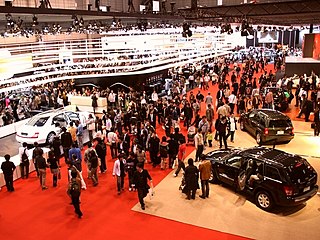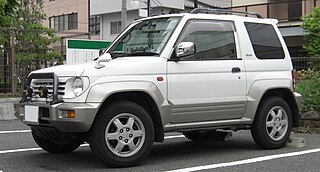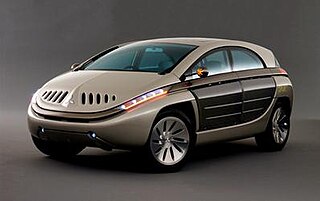
The Mitsubishi Lancer Evolution, commonly referred to as 'Evo', is a sports sedan based on the Lancer that was manufactured by Japanese manufacturer Mitsubishi Motors from 1992 until 2016. There have been ten official versions to date, and the designation of each model is most commonly a Roman numeral. All use two litre turbocharged inline four-cylinder engines and all-wheel drive systems.

The Mitsubishi Chariot is a small multi-purpose vehicle (MPV) manufactured and marketed by Mitsubishi from 1983 to 2003. Based on the SSW concept car first exhibited at the 23rd Tokyo Motor Show in 1979, the MPV derives its nameplate from chariots used by the ancient Greek and Roman Empires.

The Mitsubishi i is a kei car from automaker Mitsubishi Motors, first released in January 2006, twenty eight months after its debut at the 2003 Frankfurt Motor Show. It is the first four-door automobile since the 1960s to employ a "rear midship" setup with the engine behind the passengers, in an attempt to improve safety and interior space without enlarging the overall exterior.

The Tokyo Motor Show (東京モーターショー) is a biennial auto show held in October–November at the Tokyo Big Sight, Tokyo, Japan for cars, motorcycles and commercial vehicles. Hosted by the Japan Automobile Manufacturers Association (JAMA), it is a recognized international show by the Organisation Internationale des Constructeurs d'Automobiles, and normally sees more concept cars than actual production car introductions which is the reason why the auto press see the show as one of the motorshow's big five.

The Mitsubishi Lancer Evolution X is the tenth generation of the Lancer Evolution, a sports sedan produced by Japanese manufacturer Mitsubishi Motors.

The Mitsubishi Pajero Junior is a mini SUV produced by Japanese automaker Mitsubishi Motors between October 1995 and June 1998 for the Japanese domestic market only. Based on a lengthened Minica platform, it was a larger version of the Mitsubishi Pajero Mini, a kei car. The biggest visual difference from the Pajero Mini is the wide fender trims and wider tyres, giving it a more purposeful appearance. It did benefit from moderate ownership costs to Japanese buyers, due to the exterior dimension being within the favorable compact size class according to Japanese Government dimension regulations, and the small displacement engine obligated a minimal annual road tax, although at reduced advantage compared to the kei car-based Pajero Mini.

The Mitsubishi RVR is a range of cars produced by Japanese manufacturer Mitsubishi from 1991 to 2002 and then from 2010 until present. The first two generations were classified as compact multi-purpose vehicles (MPV), and the model introduced in 2010 is a subcompact crossover SUV.
MIEV or MiEV is the name given by Japanese automaker Mitsubishi Motors (MMC) to its alternative propulsion technologies. From late 2006, “MiEV” encompasses all of Mitsubishi Motors’s electric drive systems work, including lithium-ion batteries, in-wheel motors and other technologies related to electric vehicle(EV), hybrid-electric vehicle and fuel-cell vehicles.
The Mitsubishi HSR is a range of concept cars exhibited by Mitsubishi Motors through the late 1980s and 1990s. There were six distinct iterations of the vehicle released biannually to coincide with the Tokyo Motor Show, with each model after the original identified by a Roman numeral suffixed to the name. The meaning of the acronym varied over the years. The first iteration meant Hi-speed Running Research, the second Hi-Sophisticated Research, and the third Human Science Research.

The Mitsubishi SUP is a concept car developed by Mitsubishi Motors in 2001, first exhibited as a hardtop at the 35th Tokyo Motor Show in 2001, and later at the 2002 North American International Auto Show and Geneva Motor Show as a Mitsubishi SUP Cabriolet. The name SUP stands for "Sports Utility Pack", with Mitsubishi claiming that it was designed "for nature lovers who are...happy using hi-tech gadgets and gizmos Monday to Friday; then out for a bunch of fun communing with nature at weekends and holidays."

The Mitsubishi SUW is a series of concept cars sharing a common design theme, and first exhibited by Japanese automaker Mitsubishi Motors at the 1999 Frankfurt and Tokyo Motor Shows.
Reinforced Impact Safety Evolution (RISE) or Realized Impact Safety Evolution is the brand name of Mitsubishi's patented safety body construction system. It was first introduced in the 1996 Mitsubishi Galant. Initially designed to improve passive safety, the system has subsequently been developed to electronically integrate every aspect of car's active and passive safety features.
S-AWC is the brand name of an advanced full-time four-wheel drive system developed by Mitsubishi Motors. The technology, specifically developed for the new 2007 Lancer Evolution, the 2010 Outlander, the 2014 Outlander, the Outlander PHEV and the Eclipse Cross have an advanced version of Mitsubishi Motors' AWC system. Mitsubishi Motors first exhibited S-AWC integration control technology in the Concept-X model at the 39th Tokyo Motor Show in 2005. According to Mitsubishi Motors, "the ultimate embodiment of the company's AWC philosophy is the S-AWC system, a 4WD-based integrated vehicle dynamics control system".
All Wheel Control (AWC) is the brand name of a four-wheel drive (4WD) system developed by Mitsubishi Motors. The system was first incorporated in the 2001 Lancer Evolution VII. Subsequent developments have led to S-AWC, developed specifically for the new 2007 Lancer Evolution. The system is referred by the company as its unique 4-wheel drive technology umbrella, cultivated through its motor sports activities and long history in rally racing spanning almost half a century.

The Mitsubishi MR platform is an automobile platform first developed by Mitsubishi Motors in 2003 for their Mitsubishi i kei car. The name is derived from the Mid-engined, Rear-wheel drive ("MR") configuration, which locates the powertrain behind the rear seat and just ahead of the rear axle. This allows for a longer wheelbase and a consequently more spacious interior without compromising crashworthiness or fuel economy. However, in the case of the Evo, MR stands for Mitsubishi Racing.
Mitsubishi Motors concepts are those prototype and concept cars exhibited around the world by Mitsubishi Motors. In common with other automakers, Mitsubishi has used concept cars as both show cars—stylistically adventurous motor show exhibits with no production intentions behind them—or as precursors of future models destined for mass production.
Toyota Concept Vehicles produced between 1980 and 1989 include:










